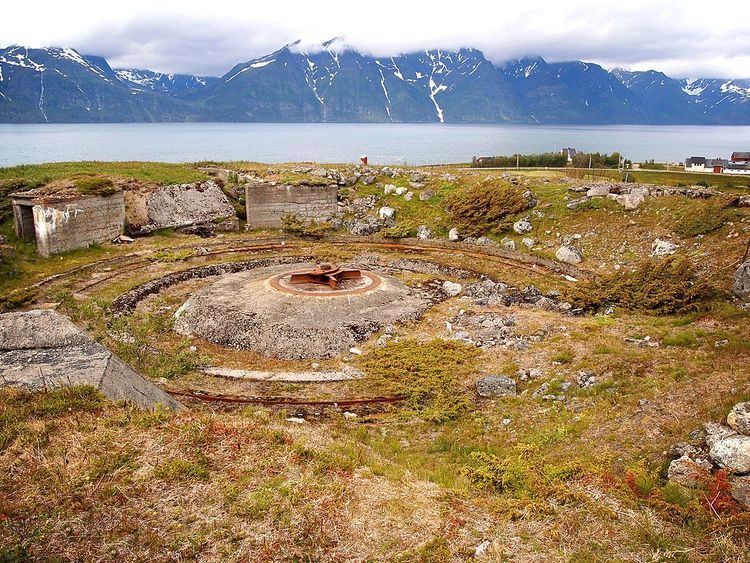 | ||
Similar Holmenes Sami Farm, Mollisfossen, Halti, Northern Lights Cathedral, Three‑Country Cairn | ||
Spåkenes fort is a ruined coastal fortress in northern Norway. It lies on the Spåkenes peninsula, which extends to the middle of the fjord Lyngen (also known in Norwegian as Lyngenfjorden), built by the Germans during World War II. The fort lies on the border of Gáivuotna–Kåfjord and Nordreisa in Troms county. The nearest village is Djupvik. Spåkenes is open to visitors and has two marked paths that present the history of the fort via drawings and fictional accounts based on real-life situations.
Contents
Background
When World War II broke out, the German navy wanted to establish naval bases in Europe to give protection to its fleet. Western Norway, with its numerous fjords and a coastline that is thousands of kilometres long, offered a strategically ideal location. By invading Norway, Germany could ensure an uninterrupted supply of iron ore from Sweden for its military industry. However, at this point, Adolf Hitler gave priority to Germany's military campaign in Western Europe.
The situation changed when the Soviet Union launched its offensive against Finland on 30 November 1939. From information contained in British navy messages that German forces decrypted, Germany became aware that Allied forces were preparing an operation in Norway under the guise of assistance to Finland. Also, the leader of the Norwegian fascist party, Vidkun Quisling, claimed that the Norwegian government was engaged in clandestine talks aimed at allowing the British forces access to army bases in Norway.
Hitler made his final decision after the Altmark Incident, in which the British Royal Navy boarded a German tanker in Norwegian waters to release the Allied merchant sailors it was transporting as prisoners. The skirmish convinced Hitler that Norway would fail to remain neutral.
As a result, Germany launched its Operation Weserübung, which meant invasion of Norway on 9 April 1940 at 4:15am.
The occupation of Norway allowed Germany to ensure the protection of its supply of iron ore from Sweden and to gain numerous naval bases. These proved pivotal when Allied troops sought to provide transport-related military assistance for the Soviet army during Operation Barbarossa, Germany's attack on the Soviet Union.
German troops in Djupvik
German troops arrived in Djupvik on the night of 28 August 1940. With the arrival of 2,000–3,000 men from these forces, the population of the village of Djupvik grew many times larger. This growth had a profound effect on the entire village. Initially, the soldiers stayed in local residents' houses.
In addition to the coastal fort, the Germans built a hospital for their soldiers and officers, where locals too were sometimes treated.
Most of the soldiers stationed at Spåkenes were young Germans transferred from Honningsvåg. Many of them turned 18 only during their posting. In many cases, the soldiers were stationed in Spåkenes for just six months.
Construction
The fort is on the hill Storbakken, the highest point of Spåkenes. The work to build the bunkers there began in 1941. The majority of the building work was carried out by Soviet prisoners of war, but German prisoners (deserters and others) were also sent to work on the bunkers.
Some 200–300 Norwegians, from Olderdalen, Rotsund, and Reisa, participated in the work. They were often put to work carrying sandbags shipped from Skjervøy to the building site from the port.
The Spåkenes coastal fort consists of four bunker complexes, each of which included a gun, ammunition bunker, trench, and infantry bunker. After the Germans left, one of the bunkers suffered extensive damage in an explosion, which may have been accidental. A fire in the gunpowder stores is one possible cause.
Artillery
The fort housed several guns with a range of up to 23,000 metres. With this range, they were capable of hitting a ship travelling off Lyngstuva, the furthest tip of the Lyngen peninsula. To enable the monitoring of a large portion of the surroundings, the command bunker was equipped with powerful binoculars. The fort never saw battle.
Prison camp
Most prisoners of war held in the prison camp were Soviet, Yugoslavian, and Polish.
The road to the local cemetery ran through the prison camp, and villagers were able to witness the conditions at the camp first hand. Local residents occasionally attempted to help the prisoners by smuggling in food. A torture chamber and gallows were built near the camp. All told, 15 prisoners were executed either by shooting or by hanging.
